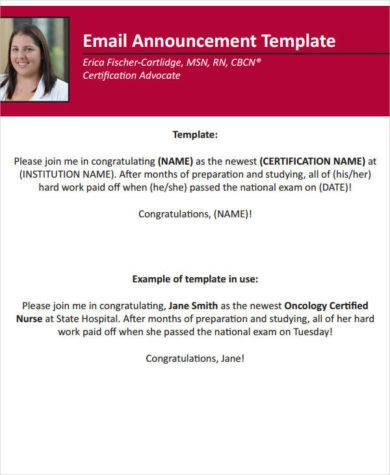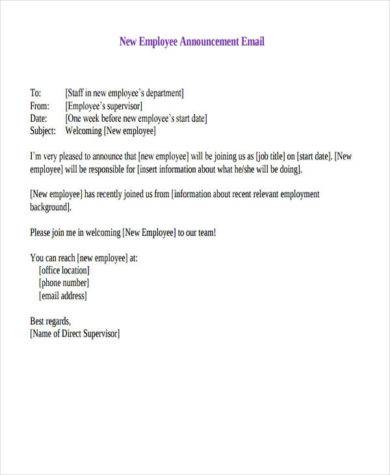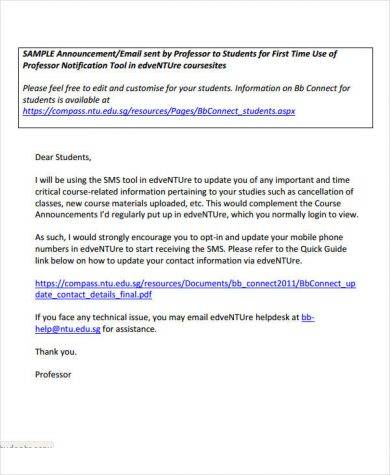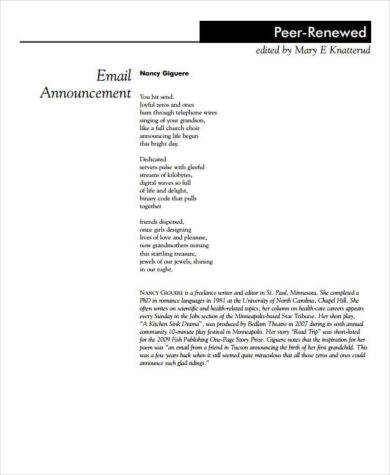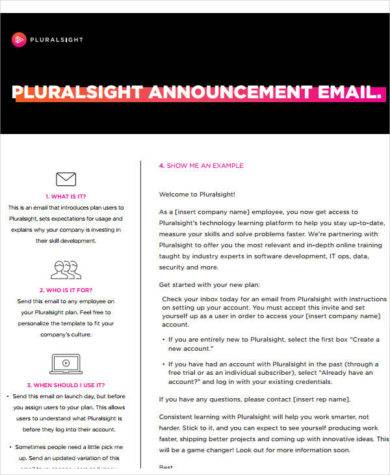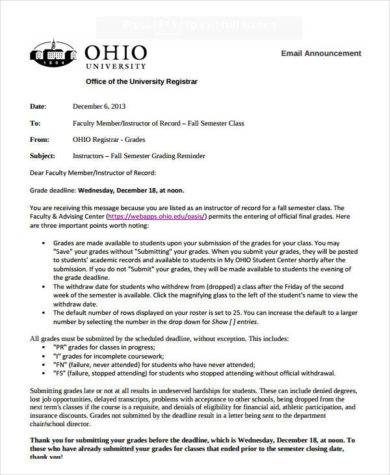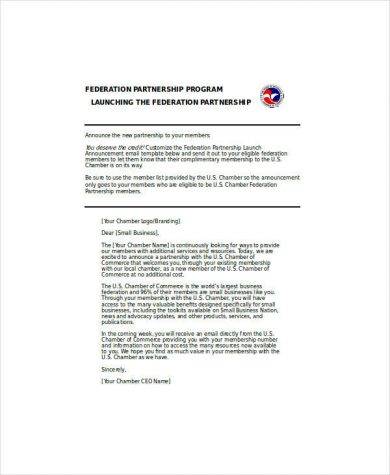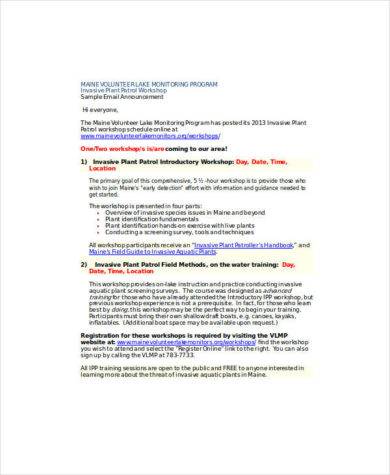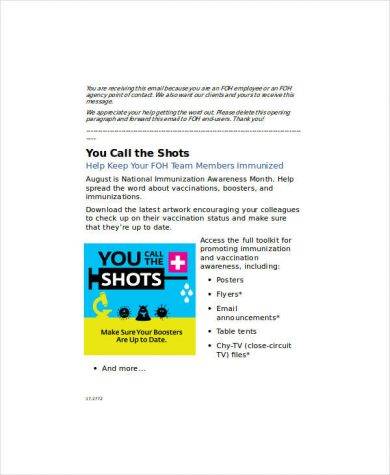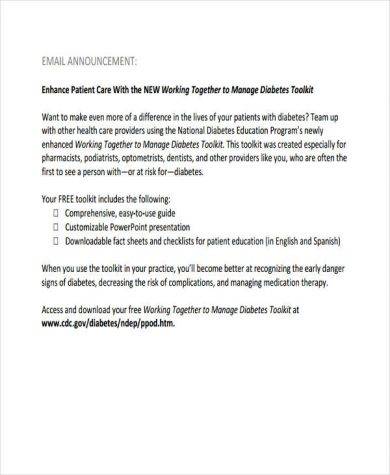10+ Email Announcement Examples to Download
Welcome to the 21st century. The period wherein no one has to wait for days for a letter to arrive from his dearly beloved or wherein the document is damaged due to unforeseen circumstances such as the weather.
Thanks to today’s technology, anything can already be sent within minutes or even seconds from important documents that require a person’s signature to application forms that need filling out, to pictures and even songs and anything really. Almost anything has now become possible, really. And thanks to social media, you no longer need to send emails just to be in constant communication with each other.
You can text or even chat with them through various social media sites. Emails these days are still a form of communication that people today still use. The only difference is, it is more practical and professional to use in the business world or when you have documents that need to be passed to your instructor. For those of you who are still very new to the usage of emails, then you may just follow these steps to make sure everything goes smoothly. You may also see meeting announcement designs.
Sample Email Announcement Template
New Employee Email Announcement
Printable Email Announcement
Formatting Your Email
1. Use a professional email address.
Normally, people would often create 2 email addresses: one for their personal use and one to be used during work. Keep in mind that it is very important that you separate the 2, otherwise, the recipient might end up getting confused on which email he or she should be sending the documents to. And another thing, in making your work email address, please do make sure that it is formal.
For instance, when your name is Takeshi Ayato, your work email cannot be like ***************** as it will seem unprofessional and unethical. But when you name your work email address like this: *****************, it would sound more suitable. You may also see moving announcement cards.
2. Stick to a professional font.
Email software and word processors have many different default fonts that can be found in font style options. For the sake of professionalism, it is recommended that you use the following fonts: Times New Roman, Verdana, or Arial. Bear in mind to keep the font style as simple as possible and as minimal as possible. It does not have to be too flashy or with too many curves and unique designs and whatnot. You may also see thank-you email examples & samples.
When writing your email, try to use font size 12 or even smaller if the font style is simply too big in that particular size. You should also avoid special styles such as italicizing and highlighting (simply making it bold and underlining the certain word or phrase would suffice) unless they are warranted by the content and purpose of the email. And last but never the least, avoid using all caps as they often appear like you are shouting at the recipient. You may also like feedback email examples & samples.
3. Use a short and accurate subject line.
Next to the one who sent the email, people will often take a look at the subject line to give them an idea as to why you sent the email in the first place. Subject lines just need to be brief and concise enough that they can understand as to what the content of the message will be.
Try to be specific as to what you need to tell your recipient in the subject line. For example, subjects like “Quick question,” “Contacting you,” or “Email about an important matter” are too vague or obvious to be useful. When you phrase your subject line like this: “Schedule, Guest List, Lunch Requests, and Meeting Overview for March 12th,” on the other hand, is overwhelmingly long and covers several topics. But when you begin to word it like this: Meeting RE: damaged escalator on March 12th,” it gives the recipient a very clear idea on what the issue is about. You may also see wedding announcements.
Creative Email Announcement
Pluralsight Email Announcement
University Register Email Announcement
Writing Your Message
1. Use a proper salutation.
When you first type in your email, it is often best to start with a proper salutation. You cannot be casual when you greet someone by simple email such as using “Hello,” “Hey,” “Hi,” or other informal salutations as it is not your friend nor your acquaintance.
Do remember that you are greeting your supervisor, boss, or teacher. So it is best that you provide them with the appropriate title (Mr., Mrs., Ms., Dr., Engr., etc.). In any case that you do not know the person that you are be greeting, you may begin your salutation with “Dear Sir/Madam” or “To whom it may concern.”
2. Introduce yourself in the first paragraph (if necessary).
If you intend to send an email to your teacher specifying your intent to submit a requirement for a certain class, then you do not exactly have to introduce yourself anymore as he or she already knows who you are considering that you are his or her student.
But, if you are writing an email that is directed to the human resource (HR) officer or just someone that you do not really know, in which case you had to make a query for a certain matter, then it would probably be best to give a small introduction about yourself. It does not have to be lengthy though; it can just be as simple as who you are and where you are from. You can always phrase it like this: “Good morning, Dr. Kovacs. My name is Xin Hua Mei, a tentative applicant of the Masters in Communication program of Tokyo University.” You may also see promotion announcement.
3. Prioritize the most important information.
Once you’ve introduced yourself and the general reason you’re writing, you can follow up with the body of your professional email. Put the most important content near the top. This respects your recipient’s time and makes the purpose of your email clear.
When writing to another school that you wish to inquire with, for instance, you might start by saying, “My name is Arlene Rivers. I was wondering as to whether you require Teaching Assistants or Graduate Researchers this coming first semester 2018 to 2019?”
4. Get to the point.
Get straight to the point in these letters as you may never know on how busy these people are.
For instance, when writing to a professor, don’t waste space with unnecessary padding like, “This is Mark Twain. Do you know me? PHYS 101 is my favorite class right now. I love the way the lectures are so organized. I can always follow along and know what will be on the tests. Speaking of tests, I was thinking about the next exam.” You may also see party announcement.
Instead, it would be much clearer to write something like, “This is Mark Twain. I’m a student in your PHYS 101 class, and I’m writing about a potential exam time conflict.”
5. Keep it brief.
Are you familiar with the Keep It Short and Simple (K.I.S.S.) rule? Yes, this rule applies especially in writing emails. Human resource officers get thousands of application letters in a single day. They do not exactly have the luxury of time to go through each of them one by one. So by all means, keep it as brief as you can. If the context of your letter is really lengthy, then it would just be best to break it down into shorter paragraphs. You may also see birth announcement.
6. Use formal language.
As mentioned before, emails are considered formal letters as well. So it would be best not to make it sound so casual. Make your formal letter sound more professional and businesslike and to do so, best avoid things like
- slang,
- unnecessary contractions,
- emoticons and emojis,
- profanity, and
- jokes.
7. Use a proper form of closing.
Just as there is a beginning, there must also be an end in your letters. By adding a closing to the letter, you acknowledge that there is nothing more to say in the letter and that you are showing courtesy to the recipient. Here are some examples of some closings that you can use:
- “Yours sincerely,”
- “Yours cordially,”
- “Respectfully,”
- “Best,”
- “Your student,”
Launch Announcement Email
Sample Email Announcement Format
Campaign Announcement Email
Preparing to Send
1. Include any necessary attachments.
In case your formal email should include any necessary and important attachments, try to point that out during the closing sentence of your letter. You can always phrase it out like this: “Attached below is my PowerPoint for Tuesday’s class discussion on the laws of gravity and why it is important to understand them.”
2. Proofread your message for content, spelling, and grammar.
They say that content is king in everything. But how can it be king when it is typed with faulty grammar? You cannot always rely on the word processor’s auto-correct feature wherein it underlines the given word red if it happens to be spelled incorrectly or underlined green if there happens to be a structure error.
Although contractions are considered to be grammatically correct, you just have to avoid listing them down in the email as it is deemed to be informal. Never forget the lessons that school has managed to teach you: pertaining to grammar and structure. In terms of the content, ensure that the introduction, the body, and the conclusion are written and organized properly in the email. You may also see business announcements.
3. Make sure that the email does not contain any sensitive information.
All those rumors you might have heard that the Internet is no longer safe and that anyone can be watching right now without you knowing it are actually true.
With the advancement of technology means the increase of hackers out there who can exploit your data and use it for blackmail. Although major tech companies often find ways and means to install safety and security features to prevent another data breach, there are always other means to prevent it from happening to you. One of the ways is to not put it in the email in the first place. You may also see graduation announcement.
Seminar Announcement Email
Medical Email Announcement
Writing a Good Email Announcement
1. Be real.
Speak in a language your employees will understand. This is not a time to let your lawyer write your email for you. If there is legalese you have to use, identify what parts your lawyer wrote and why.
2. Be human.
Write in such a way that you do not sound like a robot that does not have feeling or emotion, but write like an actual human being wherein the people reading you can feel the happiness when the company is being recognized as 4-star airline or when the chief executive officer (CEO) of the company has to resign due to health concerns. Allow your audience to feel what you’re feeling.
3. Choose your subject carefully.
As aforementioned, the subject line is the second thing that the people notice right after who sent the email. So choose a proper subject line that might get their attention so that they may browse open the content. You may also see employee announcement examples.
4. Identify the goal.
We do general announcements to get the word out to everyone, to get people on the same page and to enable them to move forward accordingly. One way to make this happen is to clearly articulate what your end game is. What challenge are you overcoming and where do you want to be once you are successful at it, or what accomplishment have you achieved and why is it important to the business?
5. Share the challenge/obstacle and the implications.
If there are some issues that the company has outlined or highlighted, it is important to address and share them with the rest of the team members and personnel so that they can come up with ways and means to counter and overcome those difficulties. You may also see staff announcement examples.
6. Apologize if needed.
If there is a need for you to apologize on the email, then do so.
7. Solutions/Steps.
Articulate the actions you are taking with milestones and commitments on when next updates will be delivered. If you have to do a big email announcement, then you need to have a plan for follow-up communication as well. You may also see baby announcement postcards.
8. Call to action.
Give your employees a way to get involved. Identify how they can help and/or what they need to do or focus on.
9. Thanks/Closure.
Recognize and appreciate those who have got you here. Encouraging words and some light at the end of the tunnel are good too. Sign off with good etiquette and respect.
10. Open door.
Always provide a way people can get their questions answered.
When making an email announcement, it is important for you to be specific and detailed. You may also see free birth announcement designs.



